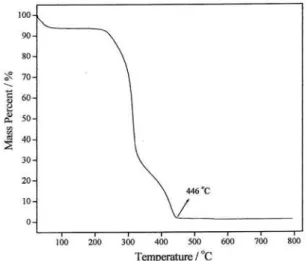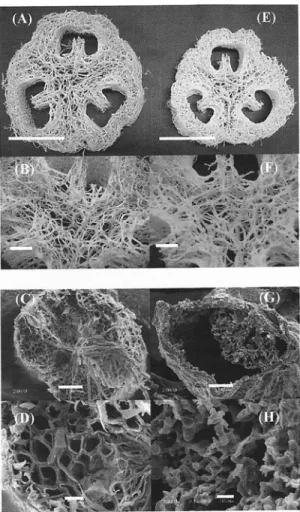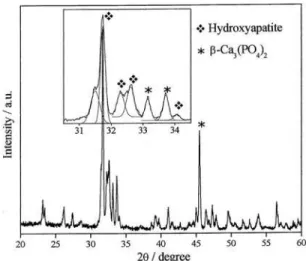www.scielo.br/aabc
Morphosynthesis: high fidelity inorganic replica of the fibrous
network of loofa sponge (
Luffa cylindrica
)
ITALO O. MAZALI and OSWALDO L. ALVES
Laboratório de Química do Estado Sólido, Instituto de Química – UNICAMP Cx. Postal 6154, 13083-970 Campinas, SP, Brasil
Manuscript received on August 16, 2004; accepted for publication on October 23, 2004;
contributed byOswaldo L. Alves*
ABSTRACT
High fidelity calcium carbonate and hydroxyapatite (bio) inorganic replicas of the fibrous network of the dried fruit ofLuffa cylindricaare described, utilizing a facile synthetic route. The loofa sponge is a highly complex macroscopic architectural template, an inexpensive and sustainable resource. In the context of the morphosynthesis, the capability of replication of the loofa sponge opens the possibility of the use of biodiversity in obtaining new materials. We would like to emphasize that the template proposed in this paper, makes possible the preparation of inorganic replicas with a very desirable size, on the centimeter scale. This fact is innovative with respect to inorganic replicas described in the literature, which predominate at the micrometric scale, limited to the original size of the template.
Key words:morphosynthesis, biomimetic synthesis, morphology, calcite, hydroxyapatite.
INTRODUCTION
Morphosynthesis consist of the chemical construc-tion and patterning of inorganic materials with un-usual and complex architecture (Ozin 1997, Walsh et al. 1999, Mann 2000). The complex inorganic ar-chitectural replication is constructed hierarchically on a length scale from the nanometer to the mil-limeter level. The controlled synthesis of inorganic materials with specific morphology is an important aspect in the development of new materials in many fields such as catalysis, electronics, nanocompos-ites, etc. From a materials perspective, biomimetic syntheses have permitted the replication of a range of organized inorganic forms using, as templates, bac-terial colonies (Li et al. 2003), insect wings (Cook
*Member Academia Brasileira de Ciências Correspondence to: Prof. Oswaldo Luiz Alves E-mail: oalves@iqm.unicamp.br
with fluoride for wettability enhancement was posed as a new foaming agent for foamed metal pro-duction (Nakamura et al. 2002). Thus, the calcium carbonate waste from water treatment can be recy-cled as a foaming agent. Calcium carbonate is also a known biomaterial with potential bioactivity (Yu et al. 2004).
The development of advanced materials for biomedical applications is among the most impor-tant problems facing modern materials engineering (Kawachi et al. 2000). The greatest potential for bone substitution is shown by materials based on hydroxyapatite, which can develop tight bonding with bone tissue, exhibits osteoconductive behav-ior, is stable toward bioresorption, and has no ad-verse effects on the human organism (Finisie et al. 2001, Orlovskii et al. 2002). Synthetic hydrox-yapatite precursors are produced by a variety of ce-ramic processing routes including precipitation, sol-gel and hydrothermal processing. The most impor-tant parameters for application of calcium carbonate and hydroxyapatite are specific surface area, parti-cle morphology, chemical and phase composition and microstructure.
However, biomimetic material will only be technologically relevant if inexpensive routes with high product yields can be developed (Walsh et al. 1999). In this context, Hall et al. (2003) described a facile and inexpensive method for replicating the complex surface morphology of flower and tree pollen grains. These replicas consist of silica, cal-cium carbonate and calcal-cium phosphate minerals.
The aim of this work was to evaluate the capability of the biomimetic synthesis of calcium carbonate and hydroxyapatite inorganic replicas of the fibrous network of loofa sponge (Luffa cylin-drica, cucurbitaceous family). The loofa sponge is a highly complex macroscopic architectural tem-plate, an inexpensive and sustainable resource. The loofa sponge is cultivated, unlike the sponge pro-duced with cellulose that is extracted from trees. The plant is cultivated in many countries, includ-ing Brazil, where its cultivation has an increasinclud-ing economic importance. The fruits of Luffa
cylin-dricaare smooth and cylindrical shaped. The fibers are composed of 60% cellulose, 30% hemicellulose, and 10% lignin and can be used by industry for many purposes, such as packaging, insulating, or filling materials. The absorbent capacity of the fibers for deionized water is 13.6 g/g (Bal et al. 2004). Tra-ditionally, it is used for bathing and dish washing and, recently, the fibers were used for environmen-tal reclamation (Iqbal and Edyvean 2004).
MATERIALS AND METHODS
The dried fruit ofLuffa cylindricawas cut into discs of ca. 10 cm diameter, 3 cm thick, washed with abundant distilled water and then dried at 60◦C.
Cal-cium carbonate and hydroxyapatite inorganic repli-cas were prepared according to a previously de-scribed procedure (Hall et al. 2003). Aqueous so-lutions of CaCl2 (3.0 mol L–1, pH 8), of Na2CO3
(3.0 mol L–1, pH 13) and of Na
2HPO4(2.0 mol L–1,
pH 10) were first prepared as stock solutions. For both inorganic replicas, the sponge was immersed in CaCl2solution for 12 h, at room temperature.
Af-ter this period, the sponge was removed from the solution and washed with distilled water to remove excess CaCl2solution. Calcium carbonate and
hy-droxyapatite were produced on the fibrous network by reimmmersion of the sponge in Na2CO3(12 h) or
Na2HPO4(12 h) solutions, respectively. The sponge
was again washed with distilled water and submit-ted to pyrolysis at 600◦C for 24 h under air
atmo-sphere after heating rate of 5◦C min–1, to produce
inorganic replicas.
In order to study the decomposition of the fi-brous network of loofa sponge, thermogravimetric analyses were carried out (TGA, Shimadzu 50WS) using an air flow rate of 20 mL min–1 and a heat-ing rate of 10◦C min–1. Powder X-ray diffraction
(XRD) patterns were obtained using a Shimadzu XRD6000 diffractometer, with Ni filters and CuKα radiation, using 30 kV and 20 mA, calibrated with Si, at a 1◦min–1 rate. Infrared spectra (IR) of KBr
reso-lution of 2 cm–1. The Raman spectra were recorded
on a Renishaw System 3000 Raman Imaging Micro-scope (ca.1µm spatial resolution) using a He-Ne laser (632.8 nm) and 8 mW of power before the en-trance optics. Scanning electron microscopy (SEM) was performed by using a JEOL JSM T-300 Micro-scope. The BET surface areas were determined by N2 adsorption using a Micromeritics 2360
instru-ment.
RESULTS AND DISCUSSION
Fig. 1 shows three mass loss steps in the TGA curve of fibers of the dried fruit ofLuffa cylindricawith total mass loss around 98.5%. The first one is re-lated to the elimination of water, with a mass loss of approximately 7%. The mass losses for the subse-quent events are 91.5%, and can be associated with the pyrolysis of the fibrous network of loofa sponge. The thermal decomposition of the fibrous network of loofa sponge is completed at 446◦C in the TGA
curve, and yields a fine black powder, related to the presence of residual carbon. Thermal decomposi-tion carried out at 600◦C for 24 yields a fine white
powder constituted of potassium carbonate (major component) and calcium carbonate, as determined by energy dispersive X-ray fluorescence spectrome-try. For this reason, after production of the calcium carbonate or hydroxyapatite on the fibrous network, the pyrolysis of the vegetable template was carried out at 600◦C for 24 h.
Fig. 2a and 2b show the very complex macro-scopic morphology of Luffa cylindrica. Cross-sectional observation of the Luffa cylindrica, by SEM (Fig. 2c and 2d), reveals that the microspongy structure is formed by multicellular fibers bonded together with a large lumen and containing small punctuations along the fibers as interconnections (Bal et al. 2004). Fig. 2e and 2f show the high-fidelity calcium carbonate macroscopic replica of
Luffa cylindrica. The hydroxyapatite replica is simi-lar. The inorganic replicas preserve the microspongy structure, as illustrated in Fig. 2g and 2h. The ca-pacity of replication of the morphology of the loofa
Fig. 1 – Thermogravimetric curve of fibers of the dried fruit of
Luffa cylindrica.
sponge is due to microspongy fibrous system that offers good accessibility to fluid associated with the high retention capacity of the fibers for aqueous so-lutions. Both inorganic replicas present a reduction in the volume between 30% and 40% in relation to the original template and they are fragile, although, sufficiently resistant to permit handling.
Powdered samples of calcium carbonate and hydroxyapatite replicas exhibit specific surface ar-eas with 1.10 m2g–1and 2.75 m2g–1, respectively.
Recently, experiments for fluoride removal from aqueous solutions were carried out with calcium cbonate and hydroxyapatite with specific surface ar-eas of 0.057 m2 g–1and 0.052 m2g–1, respectively
(Fan et al. 2003).
The three common polymorphs of calcium car-bonate (CaCO3) are vaterite, aragonite and calcite,
in order of increasing thermodynamic stability. Be-cause of their different crystal structures the three phases can be discriminated using a vibrational technique, i.e. infrared and Raman spectroscopy (Kontoyannis and Vagenas 2000, Dickinson and McGrath 2001, Vagenas et al. 2003). The stronger and more highly resolved bands at ∼ 1085 cm–1
Fig. 2 – Photographs of the fibrous network of theLuffa cylin-dricafruit (A, B; scales 5 cm, 1 cm). Cross-sectional SEM micro-graphs of the fibers of theLuffa cylindrica(C, D; scales 100µm, 20µm). Photographs of the calcium carbonate inorganic replica (E, F; scales 5 cm, 1 cm). Cross-section SEM micrographs of the calcium carbonate inorganic replica (G, H; scales 100µm, 10µm).
at 711 cm–1, 700 cm–1 and 750 cm–1 for calcite, aragonite and vaterite, respectively, were used for quantitative analysis. IR bands chosen for differen-tiation between polymorphs occur at 713 cm–1 for calcite, at 700 and 713 cm–1 for aragonite, and at 745 cm–1 for vaterite. Analysis by powder X-ray diffraction uses the reflection peak, in 2θ, at 29.5◦
for calcite, 25.0◦for vaterite, and 45.9◦for
arago-nite (Kontoyannis and Vagenas 2000, Dickinson and McGrath 2001). The calcium carbonate replica is
featured by the presence of a Raman band at 708 cm–1(Fig. 3a) and an IR band at 713 cm–1(Fig.
3b), assigned to in-plane bending vibration modes of CO2–
3in the crystalline lattice of calcite. In the XRD
pattern (Fig. 4), the presence of a peak at 29.3◦(2θ )
confirms the occurrence of the calcite polymorph of calcium carbonate.
Fig. 3 – (a) Raman and (b) IR spectra of the calcium carbonate inorganic replica.
Fig. 4 – Powder XRD patterns of the calcium carbonate inorganic replica.
symmetric ν1(PO4)A1 stretching mode of ‘free’
tetrahedral phosphate ion in the hydroxyapatite phase, Ca5(PO4)3(OH). The Raman bands
ob-served in the frequency regions 400-460 cm–1,
570-625 cm–1, and 1010-1095 cm–1are assigned,
respec-tively, toν2–,ν4– andν3-type internal PO3–4modes
(Aza et al. 1997, Silva and Sombra 2004). The synthesis of hydroxyapatite as a major phase in the calcium phosphate replica is also confirmed by the XRD pattern (Saeri et al. 2003) (Fig. 6). The cal-cium phosphate replica presents two minor phases: β-Ca3(PO4)2 (identified by XRD in Fig. 6) andβ
-Ca2P2O7. The occurrence of this latter phase was
confirmed by the presence of the IR band at 725 cm–1 (Fig. 5b), which is characteristic of the
β-Ca2P2O7 ν(P-O-P)sym mode (Waal and Hutter
1994).
Fig. 5 – (a) Raman and (b) IR spectra of the hydroxyapatite inorganic replica.
The SEM, IR, Raman and XRD results con-firm the morphosynthesis of high fidelity inorganic replicas of the fibrous network of the dried fruit ofLuffa cylindrica. As emphasized previously, the controlled synthesis of inorganic materials with spe-cific morphology is an important aspect in the devel-opment of new materials. In this context, the capa-bility of replication of the loofa sponge is consistent with the possible of use of biodiversity, with special prominence for Brazilian biodiversity, in the
obtain-Fig. 6 – Powder XRD patterns of the hydroxyapatite inorganic replica.
ing of new materials. We would like to emphasize that the template proposed in this paper, shows the possibility of preparation of inorganic replicas with desirable sizes, on the centimeter scale. This fact is innovative with regard to inorganic replicas de-scribed in the literature, in which the micrometric scale predominates, being limited by the original size of the template.
CONCLUSION
High fidelity calcium carbonate and hydroxyapatite replicas of the fibrous network of the dried fruit of
Luffa cylindricaare described, utilizing a facile syn-thetic route and an inexpensive and sustainable re-source template. The capacity of replication of the morphology of the loofa sponge is due to its mi-crospongy fibrous system that offers good acces-sibility to fluid associated with the high retention capacity of the fibers for aqueous solutions. In the context of the morphosynthesis, the capability of replication of the loofa sponge presents the possi-bility of use of the biodiversity in the obtaining of new materials.
ACKNOWLEDGMENTS
Uni-versidade de São Paulo, Brasil) for the Raman mea-surements and to Prof. C.H. Collins (Instituto de Química, Universidade de Campinas, Brasil) for English revision. This is a contribution of Millen-nium Institute for Complex Materials (Conselho Nacional de Desenvolvimento Científico e Tecno-lógico/CNPq).
RESUMO
Réplicas (bio) inorgânicas de carbonato de cálcio e de hidroxiapatita, com elevada fidelidade à morfologia fi-brosa do fruto seco da espécieLuffa cylindricasão des-critas, utilizando uma rota de síntese simples e de baixo custo. A esponja vegetal é um molde macroscópico com arquitetura altamente complexa, de baixo custo e de fonte renovável. Dentro do contexto da morfossíntese, a ca-pacidade de replicação daLuffa cylindricaacena com a possibilidade de uso da biodiversidade na obtenção de novos materiais. Enfatizamos que o molde proposto neste trabalho possibilita a preparação de réplicas inorgânicas com o tamanho desejado, em uma escala de centímetros. Este fato é inovador em relação as réplicas inorgânicas descritas na literatura, nas quais predominam a escala micrométrica, limitadas ao tamanho original do molde.
Palavras-chave: morfossíntese, síntese biomimética, morfologia, calcita, hidroxiapatita.
REFERENCES
Aza PN, Guitián F, Santos C, Aza S, Cuscó R
and Artús L.1997. Vibrational properties of
cal-cium phosphate compounds. 2. Comparison be-tween hydroxyapatite andβ-tricalcium phosphate. Chem Mater 9: 916-922.
Bal KE, Bal Y and Lallam A.2004. Gross
morphol-ogy and absorption capacity of cell-fibers from the fibrous vascular system of Loofah (Luffa cylindrica). Textile Res J 74: 241-247.
Cook G, Timms PL and Spickermann CG.2003. Exact
replication of biological structures by chemical vapor deposition of silica. Angew Chem Int Ed 42: 557-559.
Dickinson SR and McGrath KM.2001. Quantitative
determination of binary and tertiary calcium carbon-ate mixtures using powder X-ray diffraction. Analyst 126: 1118-1121.
Fan X, Parker DJ and Smith MD.2003. Adsorption
kinetics of fluoride on low cost materials. Wat Res 37: 4929-4937.
Finisie MR, Josué A, Fávere VT and Laranjeira
MCM. 2001. Synthesis of calcium-phosphate and
chitosan bioceramics for bone regeneration. An Acad Bras Cienc 73: 525-532.
Hall SR, Bolger H and Mann S.2003.
Morphosyn-thesis of complex inorganic forms using pollen grain templates. Chem Commun 22: 2784-2785.
Huang LM, Wang HT, Hayashi CY, Tian BZ, Zhao
DY and Yan YS.2003. Single-strand spider silk
templating for the formation of hierarchically ordered hollow mesoporous silica fibers. J Mater Chem 13: 666-668.
Iqbal M and Edyvean RGJ.2004. Alginate coated
loofa sponge discs for the removal of cadmium from aqueous solutions. Biotechnol Lett 26: 165-169.
Kawachi EY, Bertran CA, Reis RR and Alves OL.
2000. Bioceramics: tendencies and perspectives of an interdisciplinary area. Quím Nova 23: 518-522.
Kontoyannis CG and Vagenas NV.2000. Calcium
carbonate phase analysis using XRD and FT-Raman spectroscopy. Analyst 125: 251-255.
Li Z, Chung SW, Nam JM, Ginger DS and Mirkin
CA.2003. Living templates for the merarchical
as-sembly of gold nanoparticles. Angew Chem Int Ed 42: 2306-2309.
Mann S.2000. The chemistry of form. Angew Chem
Int Ed 39: 3392-3406.
Nakamura T, Gnyloskurenko SV, Sakamoto K,
Byakova AV and Ishikawa R.2002. Development
of new foaming agent for metal foam. Mater Trans 43: 1191-1196.
Orlovskii VP, Komlev VS and Barinov SM.2002.
Hydroxyapatite and hydroxyapatite-based ceramics. Inorg Mater 38: 973-984.
Ozin GA.1997. Morphogenesis of biomineral and
mor-phosynthesis of biomimetic forms. Acc Chem Res 30: 17-27.
Saeri MR, Afshar A, Ghorbani M, Ehsani N and
Sorrell CC.2003. The wet precipitation process of
hydroxyapatite. Mater Lett 57: 4064-4069.
Silva CC and Sombra ASB.2004. Raman
Vagenas NV, Gatsouli A and Kontoyannis CG.2003.
Quantitative analysis of synthetic calcium carbonate polymorphs using FT-IR spectroscopy. Talanta 59: 831-836.
Waal D and Hutter C.1994. Vibrational spectra of
a solid solution of cadmium and calcium pyrophos-phate. Mater Res Bull 29: 1129-1135.
Walsh D, Lebeau B and Mann S.1999.
Morphosyn-thesis of calcium carbonate (vaterite) microsponges. Adv Mater 11: 324-328.
Yang M, Hashimoto T, Hoshi N and Myoga H.1999.
Fluoride removal in a fixed bed packed with granular calcite. Wat Res 33: 3395-3402.
Yu J, Lei M, Cheng B and Zhao X. 2004. Effects


